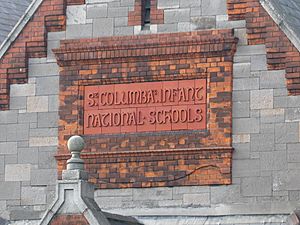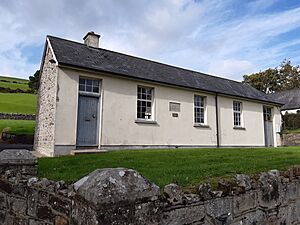National school (Ireland) facts for kids
In Ireland, a national school (Irish: scoil náisiúnta) is a type of primary school. These schools get their money directly from the government. They are usually managed by the government, a special group called a patron body, and local people. The government's Department of Education decides on big things like what students learn and how much teachers are paid. Smaller decisions are made by local people, often led by someone from the patron body, through a 'board of management'. Most primary schools in Ireland are national schools. This idea of national schools started before Ireland became independent.
There are other types of primary schools in Ireland. Some are private schools that don't get money from the government. In 2012, there were only 34 private primary schools with about 7,600 students. But in 2019, there were over 3,200 national schools with more than 567,000 students! In Northern Ireland, schools like national schools are just called primary schools.
Contents
The History of National Schools
How National Schools Started
National schools were first set up by the government of the United Kingdom of Great Britain and Ireland in 1831. This happened after something called the Stanley Letter was written. The main idea was for these schools to be "multi-denominational." This means children from different religions would learn together. A government group called the National Board of Education controlled these schools. It had six members: two Roman Catholics, two from the Church of Ireland, and two Presbyterians.
Rules for Religious Education
In the early national schools, there were clear rules about religious teaching. Teachers had to announce when religious education was starting. They would hang a sign on the wall to show that religious lessons were happening. When religious teaching finished, all religious symbols had to be put away. Parents also had the right to take their children out of religious lessons if it went against their family's beliefs. Schools that did not follow these rules, or refused to accept children of different faiths, would not get money from the government. Many of these rules are still in place today, but they are not always followed by everyone.
Early Challenges and Support
In the early 1800s, there was a lot of disagreement between different churches. The idea of multi-denominational schools was not popular with all of them. Each church wanted government help for schools that taught their own traditions.
However, some people believed in the idea of children learning together. For example, James Warren Doyle, a Roman Catholic Bishop, thought it was important. He said that if children were separated early in life because of their religion, it would be hard for peace to last in Ireland. He believed that bringing children up in the same school would help them become friends and understand each other better. He felt that separating them would "destroy some of the finest feelings in the hearts of men."
The Stanley Letter and Its Impact
In 1831, Edward Stanley, who was in charge of Ireland at the time, wrote the Stanley Letter. This letter explained the new government-supported system for primary education. This letter is still the legal basis for the national school system today. The two main rules were:
- Children of all religions would be taught together in the same school.
- Religious lessons would be taught separately.
The new system was designed to make sure no one tried to force their religion on others.
At first, the churches supported this new system. But soon, they changed their minds. However, people in Ireland were very excited about these new schools and many children started attending them.
Changes Over Time
In the second half of the 1800s, both the Catholic Church and Protestant churches eventually accepted the idea of all religions learning together. However, parents often sent their children to national schools that were managed by their own church. This meant that by the end of the 1800s, most national schools mainly had children from one religion. Even so, the law still said that all national schools were multi-denominational.
After Ireland became a Free State, the Catholic Church often tried to change this law. But the government never agreed. A report in 1953 showed that over 90% of national schools had students from only one religion. This meant that while legally multi-denominational, most schools were in practice for one religion. From 1965, new rules allowed religious education to be part of the regular school day. Today, because many people have moved to Ireland from other countries, most national schools now have students from many different religions. So, national schools are now both legally and practically multi-denominational.
School Names and Terms
Understanding School Initials
National schools don't have a strict way of being named. But sometimes, initials are used in the name to show what kind of school it is. For example, 'GNS' stands for Girls' National School, meaning it's only for girls. 'BNS' means Boys' National School. You might also see 'SN' before a school's name. This is short for the Irish language term Scoil Naisiúnta, which also means National School.
Teacher Titles
In the past, national school teachers sometimes used the letters 'N.T.' after their name. This stood for National Teacher. However, this is not common anymore.
Gallery
-
Plaque at Carnowen National School, near Raphoe in County Donegal.
-
Plaque at Curratavey National School, County Cavan.
-
Plaque at Meenbane National School, near Ballybofey in County Donegal.
-
Plaque at Castlegregory National School, County Kerry; dated 1843, it is one of the oldest National Schools.
-
Plaque at Cullen National School, County Tipperary.
See also
- Educate Together
- Gaelscoileanna (primary schools that teach through the Irish language)
- Education in Northern Ireland








